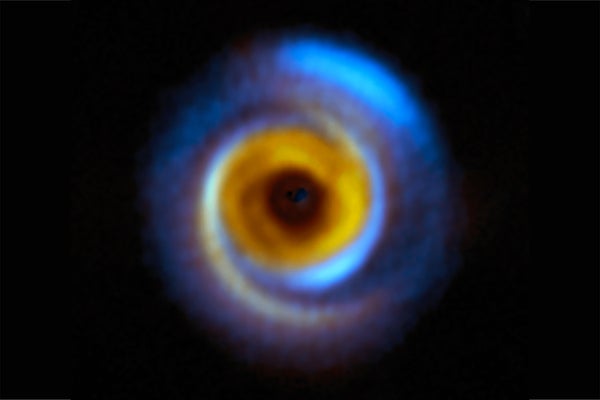Astronomers Are Snapping Baby Pictures of Planets by the Dozen
Snapshots of a plethora of planet-forming disks offer more than just eye candy—they also reveal some fundamental aspects of how worlds are born
Dust swirls around the MWC 758 planet-forming disk, located about 500 light-years away from Earth in the Taurus region, in this composite image from two different observatories. The yellow regions show scattered light from the dust, as seen by the Spectro-Polarimetric High-contrast Exoplanet REsearch (SPHERE) instrument on ESO’s Very Large Telescope (VLT); the blue regions correspond to light emitted from the warm dust, as detected by the Atacama Large Millimeter/submillimeter Array (ALMA). Such detailed views are helping astronomers see deeper than ever before into the mysterious process of planetary birth.
ESO/A. Garufi et al.; R. Dong et al.; ALMA (ESO/NAOJ/NRAO) (CC BY 4.0)
For centuries—and, frankly, until quite recently—astronomers have been baffled by planet formation. They saw these wandering points of light in the sky moving in a neat, orderly fashion, but many crucial details of how those worlds got there in the first place were a mystery.
We’ve come a long, long way since those times—and with remarkable speed. Thanks to bigger telescopes, more precise instruments and advanced digital image processing techniques, this question of how planets form has gone from speculative guesswork to a robust field of study. And, like most new scientific disciplines, it’s evolving rapidly. We used to have just a few observations of embryonic planetary systems to analyze but now have hundreds, thanks to the breathtaking pace of discovery.
In fact, astronomers have just delivered detailed observations of a staggering 86 nascent planetary families, adding a huge number of objects for researchers to gleefully analyze. And with that analysis will come a better understanding of how stars and planets are born.
On supporting science journalism
Read the full article here







